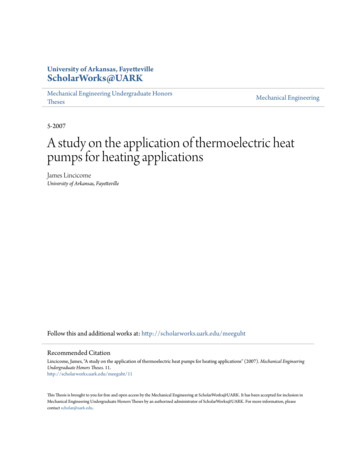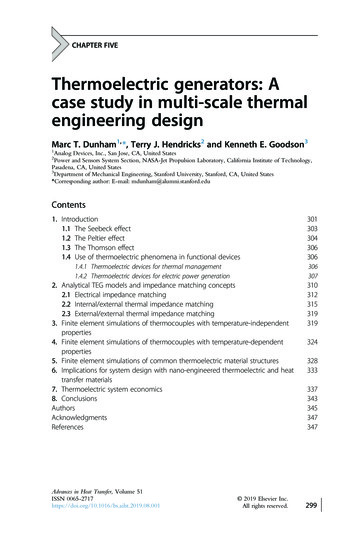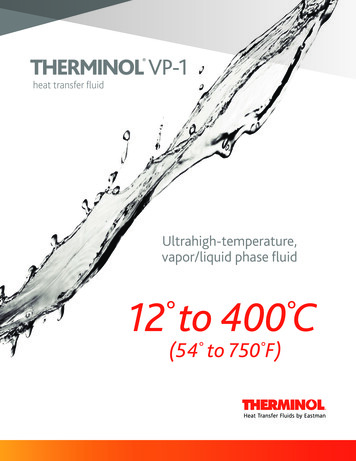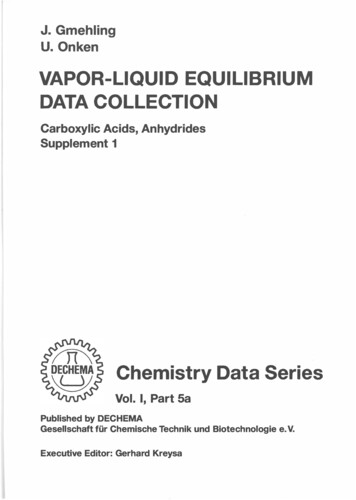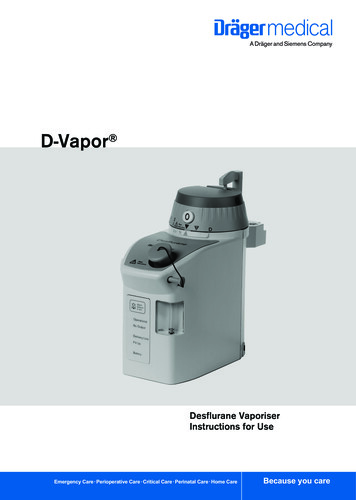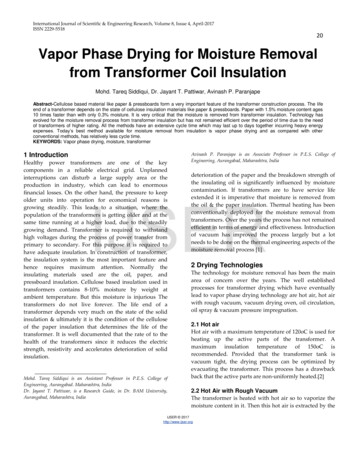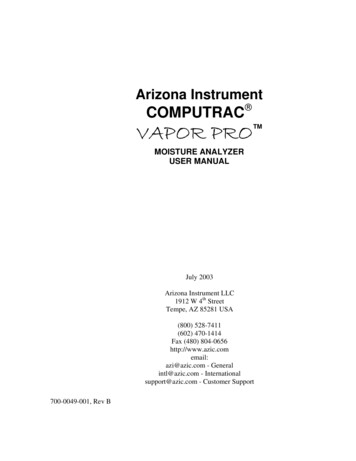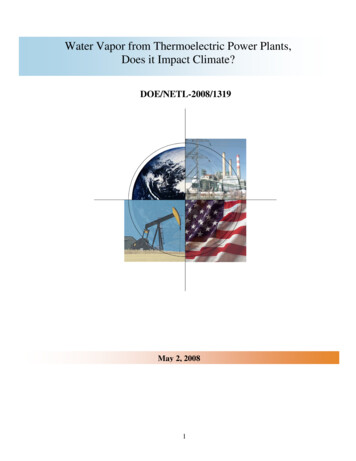
Transcription
Water Vapor from Thermoelectric Power Plants,Does it Impact Climate?DOE/NETL-2008/1319May 2, 20081
Water Vapor from Thermoelectric Power Plants, Does it Impact Climate?It is difficult to experimentally parse the radiative forcing effects of different gases in the atmosphere, but mostscientists agree that water vapor accounts for 90-95% of the total greenhouse gas effect.This leads to the question, “Do the clouds of steam billowing from power plant chimneys exert a global climatechange impact, in addition to the impact from CO2?”The greenhouse gas effects of water vapor in the atmosphere have an important impact on the global climatechange models. As the air temperature increases the air holds more water vapor, and so water vapor“amplifies” the effect of CO2 and methane emissions. This understanding was an important evolution in globalclimate change models.But there is an important fundamental difference between emissions of water vapor and emissions of CO2 andmethane. Unlike carbon dioxide and methane, the concentration of water vapor in atmosphere fluctuatesrapidly with changes in the temperature and pressure of the air. That is, a molecule of water vapor emittedfrom a power plant will condense out if and when the air gets cold, and the associated greenhouse gas effectwill end. Not so with CO2 and methane - they stay in the atmosphere and redirect photons until they undergo achemical reaction. Once emitted, these molecules can remain in the atmosphere for decades or centuries.The natural water cycle maintains a relatively constant humidity in the global atmosphere and so the effectivelifetime of water vapor emissions is a few weeks or less. It is because of this effect, the very short “lifetime” ofwater vapor emissions in the atmosphere, that water vapor emissions do not exert significant direct greenhouseeffects.The effect of clouds on the climate system is complicated and probably the least understood mechanism of theplanet’s climate. Clouds reflect sunlight, which reduces solar radiation input to the atmosphere. However,clouds also trap heat radiation emitted by the Earth, as does water vapor. Further complicating the analysis isthat clouds are highly interactive with the Earth's surface. They regulate the amount of sunlight received by thesurface and so influence evaporation from the surface, which in turn influences cloud formation. Precipitationfrom clouds, in turn, influences soil moisture and evaporation rates. Most climate models treat clouds asproviding positive feedback to temperature increases in the atmosphere i . Local perturbations in water vaporconcentrations due to human actions have been observed ii,iii , but no evidence of global climate effects has beenfound.For completeness of argument, the following analysis compares the magnitude of (1) water vapor emissionsfrom fossil fuel conversion in a thermoelectric power plant and (2) the amount of water cycled in the naturalevaporation/precipitation cycle.2
In a thermoelectric power plant, a fuel is combusted to produce heat, which then generates steam that turns anelectrical turbine. Fuels containing hydrogen and carbon (coal, petroleum, natural gas, etc.) which arecombusted in the presence of oxygen produce carbon dioxide (CO2) and water (H2O) in vapor form. The tablebelow shows how much water vapor would be produced if the current resources of all worldwide fossil fuelswere combusted at once.Table 1. Water vapor emissions if all worldwide fossil fuel resources were ces ivFuel conversionfactor1,000B tons0.9082,300B bbls0.14013,650Tcf0.020Weight offuel (Bmt) vH2O emissionsfactor fromcombustion vi(mt H2O/mt fuel)H2Oemissions(B mt)7260.453273231.424582782.25625B mt/B tonsB mt/B bblsB mt/ TcfTotal water vapor emissions from fossil fuel combustion1,410B billion, bbl barrel, mt metric ton, Tcf trillion cubic feetAfter a thermoelectric power plant’s steam has passed through the electrical turbine, it must be cooled back to aliquid, typically by an external source of water. As this external water absorbs heat from the power plant’ssteam, it evaporates and enters the atmosphere as water vapor. To estimate water vapor production fromcooling water evaporation, an evaporation factor was developed using the typical water consumption, heat rateand energy content for power plants using each fuel type.Table 2. Water vapor emissions from coal drying and cooling evaporation for all worldwide fossil fuelsFuelCoalCrude oilNatural gasWeight offuel(B mt) vii726323278H2O emissions factorfrom coal drying viii(mt H2O/mt fuel)0.2N/AN/AH2O emissions factorfrom cooling water ix(mt H2O/mt fuel)5.63.06.6Total water vapor emissions from coal drying and cooling towersH2Oemissions(B mt)4,2119691,8347,014B billion, bbl barrel, mt metric ton, Tcf trillion cubic feetThe final significant source of water vapor emissions from thermoelectric power production is from coaldrying. Coal used for power production is typically 10 to 30% moisture by weight. Many plants heat their coalbefore combustion in order to remove this moisture which enters the atmosphere as water vapor. Table 2includes both emissions of water vapor from fuel drying and cooling towers. It is important to note that coaldrying and cooling systems are active areas of research and development within the Department of Energy andelsewhere, and that advances in these areas will lead to even fewer water vapor emissions.3
Table 3. Worldwide potential emissions from power productionAmount(Billion metrictons)Water vapor sourceCombustion-basedDrying and cooling waterTotal from thermoelectric power (all worldwide fossil fuel resources)1,4107,0148,424This conservative estimate calculates that conversion of all worldwide fossil fuels for thermoelectric power willgenerate roughly 1 x 1016 kilograms (kg) of water vapor, Table 3. To put this in perspective, the currentamount of water vapor in the atmosphere is 1.3 x 1016 kg water x . Spreading the effect of the conversion over100 years gives a water vapor emissions rate of 1 x 1014 kg water vapor per year. This is roughly 1% of thetotal amount of water vapor in the atmosphere or 0.02% of annual rainfall worldwide (5 x 1017 kg water).SummaryAlthough it is widely accepted that water vapor amplifies the forcing effects of CO2, methane, and othergreenhouse gases, it does not appear likely that anthropogenic additions of water vapor to the atmosphere havea direct effect. The small scale of water vapor emissions from thermoelectric power plants and the rapidnatural response of the water cycle to changes in water vapor concentration both indicate that this is probablynot an area of concern.iSoden, B. and Held, I., An Assessment of Climate Feedbacks in Coupled Ocean–Atmosphere Models, Journalof Climate. 19, 3354-3360, (2006)iiRobinson, P. J. Temporal trends in United States dew point temperatures. International Journal ofClimatology. 20, 985–1002 (2000).iiiWang, J. X. L. & Gaffen, D. J. Late-twentieth-century climatology and trends ofsurface humidity and temperature in China. Journal of Climatology. 14, 2833–2845 (2001).ivU.S. Department of Energy, National Energy Technology Laboratory, 2006 Carbon SequestrationTechnology tions/programplans/2006/2006 sequestration roadmap.pdfDoes not include hydrates and oil-bearing shalesvProduct of the worldwide resources and conversion factor to metric tons. For coal, it is assumed that 20% ofthe mass is water. Of the total 908 B mt of coal worldwide, stoichiometric analysis is then applied to the 80%of that as dry coal.viThe emissions factor were developed using the stoichiometric equations of combusting the different fuels.This calculation assumes that the fuels are completely pure and that these are the only reactions that take place,providing a conservatively large estimate. The equations below show the stoichiometrics of combusting thedifferent fuels:Natural gas: CH4 2 O2 CO2 2 H2OCrude oil: 2 C8H18 25 O2 16 CO2 18 H2OCoal: 2 C8H5 21 O2 8 CO2 5 H2OviiFrom Table 1.4
viiiixAssumes coal used in power production is 20% moistureEmissions factors calculated by the following product:Waterconsumption1/ heatrateEnergy contentof fuelWater to vaporconversion factorFuel conversionfactorgalkWhkWhBTUBTUlb, scf, bblmt (H2O)gallb, scf, bblmt (fuel)Sub-critical pulverized coal power plant0.39 gal/kWh * (1/ 9,500 Btu coal/kWh) * 11,000 btu/lb coal * 0.00376 mt steam /gal water * 2,200 lb/mt coal 5.6 mt steam per mt coalNatual gas combined cycle power plant0.13 gal/kWh * (1/8,500 Btu NG/kWh) * 1000 btu/scf * 0.00376 mt steam /gal water * 50,000 scf / mt NG 6.6 mt steam per mt natural gasOil-fired steam power plant0.16 gal/kWh * (1/9,000 Btu petroleum/kWh) * 6,287,000 BTU/bbl * 0.00376 mt steam /gal water * 7.14 bbl /mt petroleum 3.0 mt steam per mt petroleumWater consumption factors from:Steigel, Gary etal. “Estimating Freshwater Needs to Meet Future Thermoelectric Generation Requirements”Report DOE/NETL-2006/1235, August r/ewr/pubs/WaterNeedsAnalysisPhaseI1006.pdfHeat rates are estimates of typical plant.xTrenberth, K. and Smith, L., The Mass of the Atmosphere: a Constraint on Global Analyses, National Centerfor Atmospheric Research, CLIVAR 2004 Conference, June 21-25, 2004 in Baltimore, Maryland, USA /kevin2003 6.html5
Total water vapor emissions from coal drying and cooling towers 7,014 B billion, bbl barrel, mt metric ton, Tcf trillion cubic feet The final significant source of water vapor emissions from thermoelectric power production is from coal drying. Coal used for power production is typ

